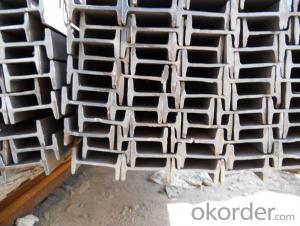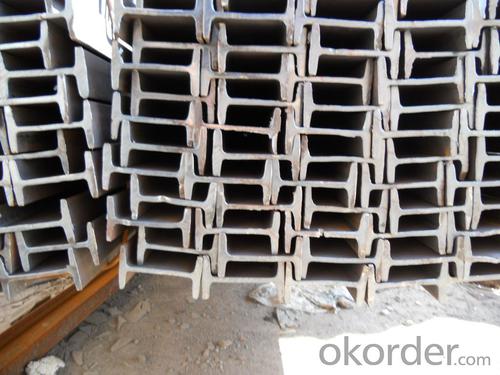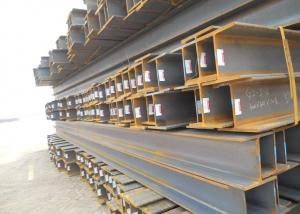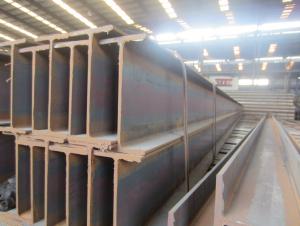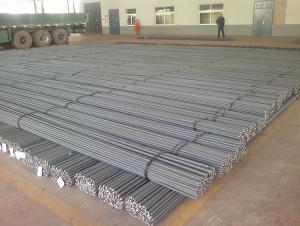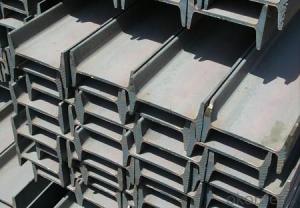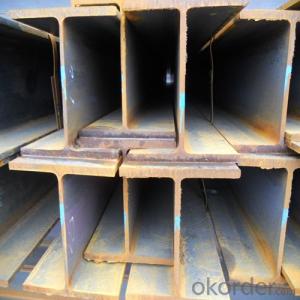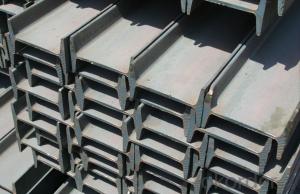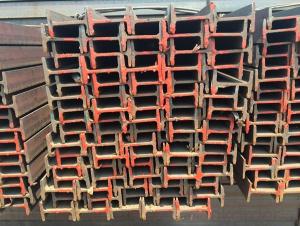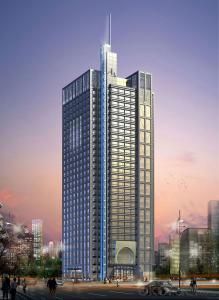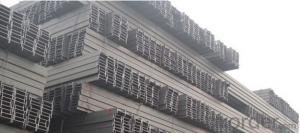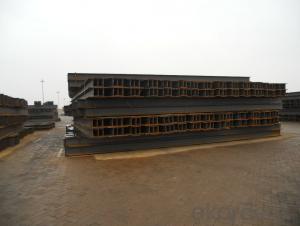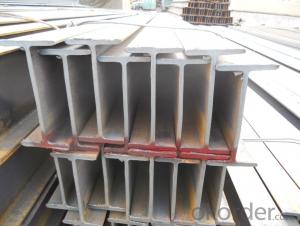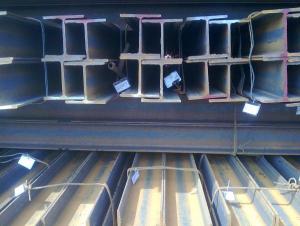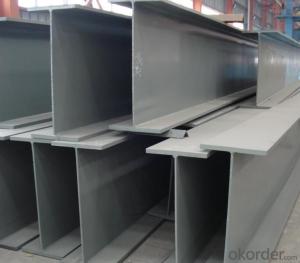Alloy Low Carbon Steel I Beam for Structure
- Loading Port:
- China Main Port
- Payment Terms:
- TT or LC
- Min Order Qty:
- 50 m.t.
- Supply Capability:
- 10000 m.t./month
OKorder Service Pledge
OKorder Financial Service
You Might Also Like
Product Description:
OKorder is offering Alloy Low Carbon Steel I Beam for Structure at great prices with worldwide shipping. Our supplier is a world-class manufacturer of steel, with our products utilized the world over. OKorder annually supplies products to African, South American and Asian markets. We provide quotations within 24 hours of receiving an inquiry and guarantee competitive prices.
Product Applications:
Alloy Low Carbon Steel I Beam for Structure are ideal for structural applications and are widely used in the construction of buildings and bridges, and the manufacturing, petrochemical, and transportation industries.
Product Advantages:
OKorder's Alloy Low Carbon Steel I Beam for Structure are durable, strong, and wide variety of sizes.
Main Product Features:
· Premium quality
· Prompt delivery & seaworthy packing (30 days after receiving deposit)
· Can be recycled and reused
· Mill test certification
· Professional Service
· Competitive pricing
Product Specifications:
Manufacture: Hot rolled
Grade: Q195 – 235
Certificates: ISO, SGS, BV, CIQ
Length: 6m-12m, as per customer request
Packaging: Export packing, nude packing, bundled
| SIZE | h(MM) | b(MM) | s(MM) | t(MM) | Mass: Kg/m | LENGTH |
| IPE100 | 100 | 55 | 4.10 | 5.70 | 8.10 | 6M/9M/12M |
| IPE120 | 120 | 64 | 4.80 | 6.30 | 10.40 | 6M/9M/12M |
| IPE140 | 140 | 73 | 4.70 | 6.90 | 12.90 | 6M/9M/12M |
| IPE160 | 160 | 82 | 5.00 | 7.40 | 15.80 | 6M/9M/12M |
| IPE200 | 200 | 100 | 5.60 | 8.50 | 22.40 | 6M/9M/12M |
| SIZE | h(MM) | b(MM) | s(MM) | t(MM) | Mass: Kg/m | LENGTH |
| IPEAA80 | 80 | 46 | 3.20 | 4.20 | 4.95 | 6M/9M/12M |
| IPEAA100 | 100 | 55 | 3.60 | 4.50 | 6.72 | 6M/9M/12M |
| IPEAA120 | 120 | 64 | 3.80 | 4.80 | 8.36 | 6M/9M/12M |
| IPEAA140 | 140 | 73 | 3.80 | 5.20 | 10.05 | 6M/9M/12M |
| IPEAA160 | 160 | 82 | 4.00 | 5.60 | 12.31 | 6M/9M/12M |
| IPEAA200 | 200 | 100 | 4.50 | 6.70 | 17.95 | 6M/9M/12M |
FAQ:
Q1: Why buy Materials & Equipment from OKorder.com?
A1: All products offered byOKorder.com are carefully selected from China's most reliable manufacturing enterprises. Through its ISO certifications, OKorder.com adheres to the highest standards and a commitment to supply chain safety and customer satisfaction.
Q2: How many tons of steel products could be loaded in containers?
A2: Usually the steel products are delivered by bulk vessel because of the large quantity and the freight. However, there are no bulk vessel enter some seaports so that we have to deliver the cargo by containers. The 6m steel product can be loaded in 20FT container, but the quantity is changed according to the size, usually from 18tons to 25tons.
Q3: How soon can we receive the product after purchase?
A3: Within three days of placing an order, we will arrange production. The normal sizes with the normal grade can be produced within one month. The specific shipping date is dependent upon international and government factors, the delivery to international main port about 45-60days.
Images:
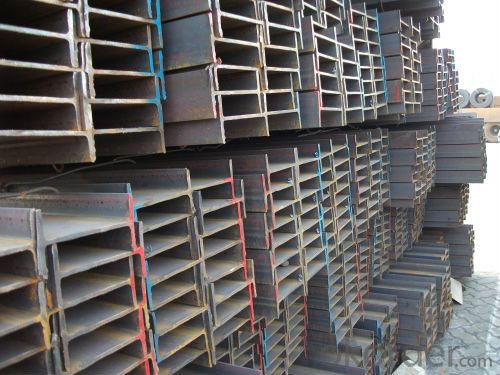
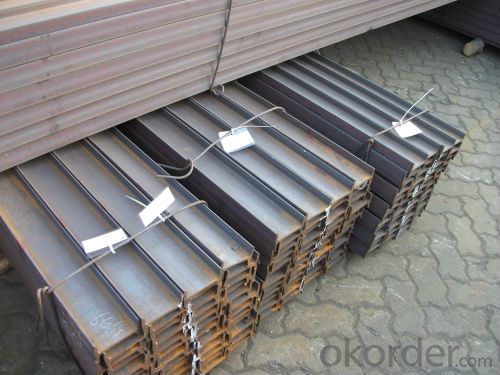
- Q: Can steel H-beams be used in mezzanine or elevated flooring systems?
- Yes, steel H-beams can be used in mezzanine or elevated flooring systems. Steel H-beams provide strong structural support and are commonly used in construction for their durability and load-bearing capabilities. They are suitable for creating stable and secure elevated platforms such as mezzanines or flooring systems.
- Q: Can steel H-beams be used in residential pergola or canopy structures?
- Residential pergola or canopy structures can indeed utilize steel H-beams. Renowned for their robustness and longevity, these H-beams are ideal for bearing heavy loads and maintaining structural stability. They are capable of withstanding diverse weather conditions, such as wind, rain, and snow, thereby guaranteeing the durability and safety of the pergola or canopy structure. Additionally, steel H-beams provide a sophisticated and contemporary look, enhancing the overall design's aesthetic appeal. Nevertheless, it is crucial to seek guidance from a structural engineer or a skilled contractor to guarantee appropriate installation and compliance with local building codes and regulations.
- Q: What is the purpose of using H-beams?
- H-beams, also known as I-beams or universal beams, serve a crucial purpose in the construction industry. The primary purpose of using H-beams is to provide structural support and strength to various structures, including buildings, bridges, and other infrastructure projects. One of the key advantages of H-beams is their unique shape, which resembles the letter "H" when viewed from the cross-section. This design allows H-beams to distribute weight evenly and efficiently, making them ideal for carrying heavy loads and resisting bending or deflection. The top and bottom flanges of the beam provide resistance against compressive and tensile forces, while the web in between ensures stability and prevents buckling. The purpose of using H-beams is to create a stable and durable framework for various structures, ensuring their longevity and safety. H-beams are frequently used in the construction of high-rise buildings, as they can support significant vertical loads, such as the weight of multiple floors, walls, and equipment. Additionally, H-beams are commonly utilized in bridge construction, where their strength and load-bearing capacity are crucial. By using H-beams, engineers can design bridges that can withstand heavy traffic loads and environmental forces, ensuring the safety and functionality of these critical transportation structures. Furthermore, H-beams find applications in industrial structures, such as warehouses and factories, where they provide the necessary support for heavy machinery, cranes, and storage systems. The robustness and stability of H-beams make them an excellent choice for such applications, ensuring the integrity and functionality of the structures. In summary, the purpose of using H-beams is to provide structural support and strength to various construction projects, including buildings, bridges, and industrial structures. Their unique shape and design allow for efficient weight distribution, resistance against bending, and overall stability, making them an essential component in modern construction practices.
- Q: Can steel H-beams be used in the construction of railway infrastructure?
- Certainly! Steel H-beams are suitable for the construction of railway infrastructure. Commonly referred to as I-beams or universal beams, these H-beams are widely used in construction due to their structural strength and versatility. They are designed to withstand heavy loads and provide stability, making them appropriate for various applications in railway infrastructure. Railway bridges, tracks, and other supporting structures can all benefit from the utilization of steel H-beams. They are frequently employed as girders to support the weight of railway tracks, ensuring stability and durability. Additionally, H-beams can be utilized in the construction of railway buildings such as stations and platforms. The advantages of using steel H-beams in railway infrastructure construction are numerous. Their high strength-to-weight ratio allows for efficient use of materials while maintaining structural integrity. Corrosion resistance is also a key attribute, particularly for railway infrastructure exposed to harsh weather conditions. Furthermore, steel H-beams can be customized to specific sizes and shapes to meet the requirements of a particular railway project. In summary, steel H-beams are an excellent choice for the construction of railway infrastructure due to their strength, durability, and versatility. They provide the necessary support and stability for railway tracks, bridges, and other structures, ensuring the safe and efficient operation of the railway system.
- Q: What are the different types of steel H-beam connections used in bridge design?
- Some of the different types of steel H-beam connections used in bridge design include welded connections, bolted connections, and riveted connections.
- Q: What are the different types of coatings available for steel H-beams?
- Steel H-beams have several different types of coatings available, each with its own unique benefits and properties. Some commonly used coatings for steel H-beams include: 1. Galvanized Coatings: Galvanized coatings are widely used for steel H-beams. This involves applying a layer of zinc to the steel surface through hot-dip or electroplating. Galvanized coatings provide excellent corrosion resistance, making them ideal for outdoor or moisture/chemical-exposed applications. 2. Epoxy Coatings: Epoxy coatings offer great durability and chemical resistance. They are applied as a liquid and then cured to create a protective layer. Epoxy coatings provide superior protection against corrosion and abrasion, making them suitable for harsh environments like chemical plants or marine structures. 3. Powder Coatings: Powder coatings are popular for steel H-beams due to their durability and aesthetic appeal. Applied as a dry powder and cured with heat, they form a hard protective layer. Powder coatings resist chipping, scratching, and fading, making them ideal for applications where appearance matters. 4. Paint Coatings: Paint coatings are a cost-effective option for protecting steel H-beams. Depending on specific requirements, acrylic, alkyd, or epoxy-based paints can be used. Paint coatings offer good corrosion resistance and can be customized for different colors or environmental conditions. 5. Fire-resistant Coatings: Fire-resistant coatings are designed to protect against high temperatures and flames. They help prevent weakening or collapsing of steel H-beams in case of fire. Fire-resistant coatings are commonly used in buildings, bridges, or structures where fire safety is a concern. Choosing the right coating for steel H-beams depends on factors like corrosion resistance, durability, aesthetics, and fire protection requirements. Consulting with professionals or coating manufacturers can help determine the most suitable type of coating for a specific application and environment.
- Q: Are steel H-beams susceptible to fatigue?
- Yes, steel H-beams are susceptible to fatigue. Fatigue is the weakening and failure of a material due to repeated stress cycles. Steel H-beams, like any other structural components, can experience fatigue if they are subjected to repeated or fluctuating loads over time. The repeated stress cycles can lead to the initiation and propagation of cracks in the material, ultimately resulting in failure. Factors such as the magnitude, frequency, and duration of the applied loads, as well as the quality and condition of the steel, can influence the susceptibility to fatigue. To prevent fatigue failure, engineers and designers must carefully consider the expected loads and apply appropriate design criteria, such as incorporating safety factors, conducting fatigue analysis, and implementing proper maintenance and inspection programs.
- Q: Can Steel H-Beams be used in convention center or exhibition hall construction?
- Yes, Steel H-Beams can be used in convention center or exhibition hall construction. Steel H-Beams are commonly used in the construction industry for their strength and durability. They provide structural support and stability to large buildings, making them ideal for convention centers and exhibition halls that often require large open spaces and high ceilings. Steel H-Beams are capable of withstanding heavy loads and can be easily fabricated and installed, making them a popular choice in the construction of such facilities. Additionally, the versatility of steel allows for various design possibilities, enabling architects and engineers to create unique and visually striking structures.
- Q: How do steel H-beams perform in terms of energy efficiency?
- Steel H-beams are highly energy-efficient due to their excellent structural properties. Their shape provides optimal strength-to-weight ratio, enabling them to bear heavy loads with minimal material usage. This reduces the overall energy required for manufacturing, transportation, and construction processes. Additionally, steel is a recyclable material, further enhancing its energy efficiency.
- Q: Can steel H-beams be used for supporting highway or railway bridges?
- Certainly, steel H-beams are suitable for supporting highway or railway bridges. Due to their exceptional load-bearing capacity and structural strength, steel H-beams are extensively utilized in bridge construction. They offer a robust framework for constructing bridges that can endure heavy traffic loads and diverse environmental conditions. The H-shape of the beams permits superior load distribution, making them perfect for supporting vast spans and heavy loads commonly encountered in highway or railway bridges. Furthermore, steel H-beams are recognized for their durability, resilience, and resistance to corrosion, thus making them appropriate for long-term utilization in bridge construction. Moreover, steel H-beams are easily fabricated and installed, enhancing their appeal for bridge construction projects. By employing appropriate engineering design and construction techniques, steel H-beams can provide the necessary support and stability essential for safe and efficient transportation across highways or railways. Nevertheless, it is crucial to emphasize that engineers and architects must meticulously determine the specific design and dimensions of the steel H-beams based on the requirements of the bridge project, such as span length, load-bearing capacity, and projected traffic loads. Additionally, regular inspections and maintenance must be conducted to ensure the sustained safety and durability of the bridge structure.
Send your message to us
Alloy Low Carbon Steel I Beam for Structure
- Loading Port:
- China Main Port
- Payment Terms:
- TT or LC
- Min Order Qty:
- 50 m.t.
- Supply Capability:
- 10000 m.t./month
OKorder Service Pledge
OKorder Financial Service
Similar products
Hot products
Hot Searches
Related keywords
